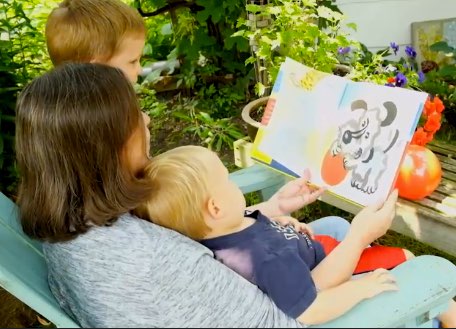What exactly is active reading?
Active reading is a style of reading to a young child that includes conversation.
We’re all pretty familiar with the standard way to read a book to a child–you start with the title and read the exact words on each page from first to last. There’s nothing wrong with that, but active reading helps a child stay interested, gain new language, and build more background knowledge. All that with only an investment of a small amount of additional time!
Three steps to an active reading story time:
- Use the cover and title to hook interest
- Point to pictures to link to the language of the story
- Add knowledge with story-to-child connections
Hook Interest with the Cover and Title
Active reading starts before the book is opened. Whether you chose the book or your child found it and plunked it onto your lap (Read to me!), active reading starts with the adult showing genuine interest.
What to do: Read the title and ask your child about the picture on the cover. Give a hint if needed. Oh, look at the animals! Which ones do you know? If it’s a familiar and well-loved book, recognize this old friend. Corduroy! This is one of our favorites!
Why it works: The quick stop for the cover and title will start your child thinking about what he already knows about giraffes, trains, pets, pizza, etc. For a familiar story, reading the title calls to mind past readings and his favorite pages. This tunes in attention and focuses interest.
Future bonus: When your child is reading on his own, this early habit of thinking about the title and cover and what he already knows about the topic will help him be a stronger reader.
Point to the Pictures to Link to Language
While you are focused on the words, your child is busy with the pictures. The words alone don’t tell the whole story–pictures can add details or plot twists not found in the words. Talking about the pictures gives your child a chance to contribute his own words to the story.
What to do: While reading, stop for regular picture checks. Show me what happened to Daisy’s red ball. For the youngest children, you do both the asking and picture finding. Do you see the bunny? Here he is! Preschoolers also enjoy finding details in the pictures that weren’t mentioned in the text. Look, I see a tiny pet in this picture. Can you find him? Encourage your child to use the pictures and his own words to tell more about the plot of the story, predict what will happen next, or retell part of a familiar story.
Why it works: Stopping to “read” the pictures adds a child’s words to the author’s words. How he interprets the pictures show how he understands the story–you can add more explanation if needed. When you take time with the pictures, you show that both the words and pictures help tell the story.
Add Knowledge with Story-to-Child Connections
You already have a pretty good idea of what your child knows. During active reading you can help grow that knowledge. Your comments help your child draw the line between his own experiences and new words and ideas from the story.
What to do: Connect your child’s experiences and knowledge to the story. Ask about a new word here and there–use the pictures to clarify meanings or share words with similar meanings, if needed. Ask questions that help your child think about the events of the story in terms of what he already knows and stretch his thinking. A few examples of questions and conversation starters:
What does this reminds you of?
Do you remember when…?
That’s like….
What do you think about that?
Why it works: Active story reading builds a child’s vocabulary and background knowledge. The new experiences and information in the story synch up with your child’s existing knowledge–and stick. Your comments guide this connection.
Remember that active reading is a style of reading–not a checklist. Defining every new word and discussing all possible picture details is definitely not the goal. With active reading you share your interest in a great story, encourage his use of language, and grow his foundation of background knowledge. Active reading creates a reading time you will both remember!



